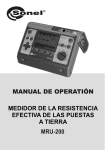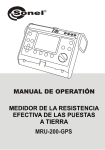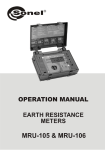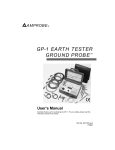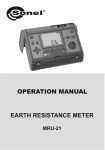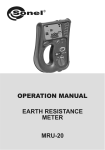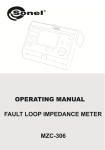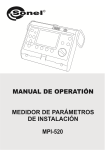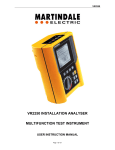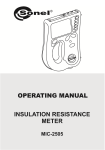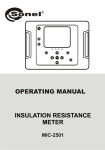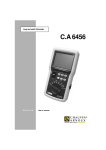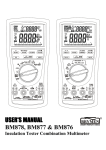Download User Manual
Transcript
OPERATING MANUAL EARTH RESISTANCE METER MRU-200 SONEL S. A. ul. Wokulskiego 11 58-100 Świdnica Version 4.6 September 23, 2014 The MRU-200 meter is a modern, easy and safe measuring device. Please acquaint yourself with the present manual in order to avoid measuring errors and prevent possible problems related to operation of the meter. 2 MRU-200 OPERATING MANUAL Version 4.6 TABLE OF CONTENTS 1 SAFETY ................................................................................................................... 5 2 MENU....................................................................................................................... 6 2.1 WIRELESS TRANSMISSION ....................................................................................... 6 2.2 MEASUREMENT SETTINGS ....................................................................................... 6 2.2.1 Mains frequency ........................................................................................... 7 2.2.2 Calibration of the measurement clamp C-3 ................................................. 7 2.2.3 Earth resistivity settings ............................................................................... 9 2.3 METER SETTINGS..................................................................................................... 9 2.3.1 LCD contrast ................................................................................................ 9 2.3.2 LCD Backlight ............................................................................................ 10 2.3.3 AUTO-OFF settings ................................................................................... 10 2.3.4 Display settings .......................................................................................... 10 2.3.5 Date and time ............................................................................................. 11 2.3.6 Battery discharging .................................................................................... 11 2.3.7 Programme update ..................................................................................... 11 2.4 LANGUAGE CHOICE ............................................................................................... 12 2.5 INFORMATION ON THE MANUFACTURER ................................................................ 12 3 MEASUREMENTS ............................................................................................... 13 3.1 MEASUREMENT OF EARTH CONNECTION AND EQUIPOTENTIAL BONDING (2P) ....... 13 3.2 CALIBRATION OF THE TEST LEADS ......................................................................... 14 3.2.1 Auto-zeroing on .......................................................................................... 14 3.2.2 Auto-zeroing off .......................................................................................... 15 3.3 MEASUREMENT 3P ................................................................................................ 16 3.4 MEASUREMENT 4P ................................................................................................ 19 3.5 MEASUREMENT 3P + CLAMP ................................................................................. 22 3.6 TWO-CLAMP MEASUREMENT ................................................................................. 24 3.7 MEASUREMENT 4P .............................................................................................. 26 3.8 CURRENT MEASUREMENT ..................................................................................... 29 3.9 EARTH RESISTIVITY MEASUREMENTS .................................................................... 31 4 MEMORY .............................................................................................................. 34 4.1 4.2 4.3 5 SAVING OF THE MEASUREMENT RESULTS IN THE MEMORY .................................... 34 MEMORY ERASING ................................................................................................ 35 MEMORY BROWSING ............................................................................................. 36 DATA TRANSMISSION ...................................................................................... 37 5.1 5.2 5.3 COMPUTER CONNECTION ACCESSORIES................................................................. 37 CONNECTION OF THE METER TO A COMPUTER ....................................................... 37 DATA TRANSMISSION WITH OR-1 RADIO MODULE ................................................. 37 MRU-200 OPERATING MANUAL Version 4.6 3 6 POWER SUPPLY ..................................................................................................39 6.1 6.2 6.3 6.4 6.5 6.6 MONITORING OF THE POWER SUPPLY VOLTAGE .....................................................39 REPLACEMENT OF ACCUMULATORS .......................................................................39 FUSE REPLACEMENT ..............................................................................................40 CHARGING OF ACCUMULATORS .............................................................................40 DISCHARGING OF ACCUMULATORS ........................................................................42 GENERAL PRINCIPLES REGARDING USING NI-MH ACCUMULATORS .......................42 7 CLEANING AND MAINTENANCE ...................................................................43 8 STORAGE ..............................................................................................................43 9 DISMANTLING AND DISPOSAL ......................................................................43 10 TECHNICAL DATA .............................................................................................44 10.1 BASIC DATA........................................................................................................44 10.2 ADDITIONAL DATA..............................................................................................47 10.2.1 Influence of the serial interference voltage UZ upon earth resistance measurements for functions 3P, 4P, 3P + clamp ........................................47 10.2.2 Influence of the serial interference voltage UZ upon earth resistance measurements for function ρ .......................................................................47 10.2.3 Influence of the auxiliary electrodes upon earth resistance measurements for function 3P, 4P, 3P + clamp .................................................................47 10.2.4 Influence of the auxiliary electrodes upon earth resistance measurements for function ρ...............................................................................................47 10.2.5 Influence of the auxiliary electrodes upon earth resistance measurements by means of the percussive method .............................................................48 10.2.6 Influence of the interference current IZ upon the result of the earth resistance measurement 3P+clamp ............................................................48 10.2.7 Influence of interference current upon the result of the earth resistance measurement using double clamps .............................................................48 10.2.8 Influence of the relation of the resistance measured with clamp for the multiple earthing branch to the resultant resistance (3P + clamp) ............48 10.2.9 Additional uncertainties in accordance with IEC 61557-4 (2P) ................49 10.2.10 Additional uncertainties in accordance with IEC 61557-5 (3P, 4P, 3P + clamp) ................................................................................................49 11 ACCESSORIES .....................................................................................................49 11.1 11.2 BASIC ACCESSORIES ...........................................................................................49 ADDITIONAL ACCESSORIES .................................................................................50 12 POSITIONS OF THE METER’S COVER .........................................................51 13 MANUFACTURER ...............................................................................................51 4 MRU-200 OPERATING MANUAL Version 4.6 1 Safety The MRU-200 meter has been designed to realise measurements whose results determine the safety conditions of the installation. Therefore, in order to provide conditions for correct operation and the correctness of the obtained results, the following recommendations must be observed: Before you proceed to operate the meter, acquaint yourself thoroughly with the present manual and observe the safety regulations and specifications determined by the producer. The MRU-200 meter has been designed for the purpose of measurements of earth connection and equipotential bonding, ground resistivity, as well as clamps current measurements. Any application that differs from those specified in the present manual may result in a damage to the device and constitute a source of danger for the user. The device must be operated solely by appropriately qualified personnel with relevant certificates to realise measurements of electric installation. Operation of the meter realised by unauthorised personnel may result in damage to the device and constitute a source of danger for the user. Using this manual does not exclude the need to comply with occupational health and safety regulations and with other relevant fire regulations required during the performance of a particular type of work. Before starting the work with the device in special environments, e.g. potentially firerisk/explosive environment, it is necessary to consult it with the person responsible for health and safety. It is unacceptable to operate the following: A damaged meter which is completely or partially out of order, A meter with damaged test leads insulation, A meter stored for an excessive period of time in disadvantageous conditions (e.g. excessive humidity). If the meter has been transferred from a cool to a warm environment of a high level of relative humidity, do not realise measurements until the meter has been warmed up to the ambient temperature (approximately 30 minutes). Before measurements may commence, make sure the test leads are connected to the appropriate measurement sockets. Do not operate a meter with an open or incorrectly closed battery (accumulator) compartment or power it from other sources than those specified in the present manual. The meter’s inputs are electronically protected from power surge, as a result for example, of accidental connection to the power supply source: - for all input combinations – up to 276V for 30 seconds. Repairs may be realised solely by an authorised service point. The device complies with the following norms; EN 61010-1 and EN 61557-1, -4, -5. Note: The manufacturer reserves the right to modify the appearance, accessories and technical data of the meter. Note: An attempt to install drivers in 64-bit Windows 8 may result in displaying "Installation failed" message. Cause: Windows 8 by default blocks drivers without a digital signature. Solution: Disable the driver signature enforcement in Windows. MRU-200 OPERATING MANUAL Version 4.6 5 2 Menu The menu is available at any position of the knob. Press MENU. Using buttons and highlight the required position. Press ENTER to select the option. 2.1 Wireless transmission See chapter 5.3. 2.2 Measurement settings Using buttons and highlight the required position. Press ENTER to select the option. 6 MRU-200 OPERATING MANUAL Version 4.6 2.2.1 Mains frequency It is necessary to determine the frequency of the mains which is the source of potential interference in order to select the appropriate frequency of the measurement signal. Solely measurements based upon the correct frequency of the measurement signal will guarantee the optimum interference filtering. The meter is adapted for filtering of interference from 16 2/3Hz, 50Hz, 60Hz and 400Hz networks. It also has the function of automatic specification of the parameter in question (selection of the mains frequency = AUTO), which is based upon the result of measurements of the interference voltage realised before the earth resistance measurement. The function is active if the interference voltage UN ≥ 1V. Otherwise the meter adopts the last frequency value selected from the MENU. Using buttons and select the frequency and press ENTER to select the option. 2.2.2 Calibration of the measurement clamp C-3 The clamp bought apart for a meter that was purchased before must be calibrated before it is used for the first time. It may be periodically calibrated in order to avoid the influence of the ageing elements upon the resolution of measurements. The procedure of calibration must be realized also after clamp has been replaced. Having read the preliminary information ENTER. Follow the displayed instructions. MRU-200 OPERATING MANUAL Version 4.6 7 Once the calibration has been successfully concluded, The following will be displayed. The meter has determined the correction factor for connected clamp. The factor is saved in the memory also when the power supply of the meter is off until the following successful calibration of the clamp has been performed. Note: - Make sure the test lead passes centrally through the clamp. Additional information displayed by the meter Message Cause The clamp is not connected ERROR: CLAMP NOT CONNECTED OR NOT PUT ON WIRE CONNECTED TO H AND E SOCKET! ERROR: WIRE NOT CONNECTED TO H AND E TERMINAL! CALIBRATION ABORTED. PRESS ENTER 8 No wire Procedure Check whether the clamp is connected to the device or whether it is placed upon the test lead used by the meter to force the passage of current. Revise the connections MRU-200 OPERATING MANUAL Version 4.6 Message ERROR: CALIBRATION COEFFICIENT OUT OF RANGE. CALIBRATION ABORTED. PRESS ENTER Cause Incorrect calibration factor Procedure Check the quality of the connections and/or replace the clamp. 2.2.3 Earth resistivity settings Using buttons , , and select the result and the distance unit and press ENTER to confirm. 2.3 Meter settings 2.3.1 LCD contrast Using the buttons and set the contrast value and press ENTER. MRU-200 OPERATING MANUAL Version 4.6 9 2.3.2 LCD Backlight Use , to set the time for LCD backlight shut-off and press ENTER to confirm. 2.3.3 AUTO-OFF settings The setting determines the time before the automatic turning-off of the device when it is not in use. Use buttons and to set the time or AUTO-OFF disable, press ENTER. 2.3.4 Display settings The setting permits to turn on/off the setting bar display. Use buttons play of the setting bar (measurement parameters), press ENTER. Visible bar 10 and Hidden bar MRU-200 OPERATING MANUAL Version 4.6 to set the dis- 2.3.5 Date and time Use buttons and to select the value to be modified (Day, month, hour, minute). Use buttons and to set the value. Once the date and time have been set, press ENTER. 2.3.6 Battery discharging The procedure is fully described in chapter 6.4. 2.3.7 Programme update NOTE! The function is designed to be used solely by those users who are familiar with computer equipment. The guarantee does not cover faults caused by incorrect application of this function. NOTE! Before you proceed to programming, charge the accumulators. During programming do not turn the meter off or disconnect the transmission cable. Before you proceed to updating the programme, download from the manufacturer’s web page (www.sonel.pl) the meter programming software, install it in the computer and connect the meter to the computer. Having chosen the Program update in the MENU, proceed in accordance with the instructions displayed by the programme. MRU-200 OPERATING MANUAL Version 4.6 11 2.4 Language choice Use buttons Use buttons 2.5 to select **Language choice** in the main MENU and press ENTER. to select the language and press ENTER. Information on the manufacturer Use buttons 12 and and and in order to select Product info and press ENTER. MRU-200 OPERATING MANUAL Version 4.6 3 Measurements Note: During measurements the status bar is displayed. 3.1 Measurement of earth connection and equipotential bonding (2P) Note: The measurement complies with the requirements specified in the norm EN 61557-4 (U<24V, I>200mA for R≤10Ω). Turn the meter on. Set the rotational function selector at 2P. Connect the object being measured to the terminals S and E of the meter. The meter is ready for measurement. The auxiliary display shows the value of the interference voltage and its frequency. The setting bat shows the mains frequency set in the MENU. MRU-200 OPERATING MANUAL Version 4.6 13 Press START In order for the test to commence. Read out the result. The result is displayer for 20s. It may be displayed again ENTER is pressed. Additional information displayed by the meter R>19,99kΩ UN>40V! and a continuous sonic signal The voltage on the measurement points exceeds 40V, the measurement is blocked. The voltage on the measurement points exceeds 24V but lower than 40V, the measurement is blocked. The value of the interfering signal is too high, the result may be distorted by additional uncertainty. UN>24V! NOISE! 3.2 Measurement range exceeded. Calibration of the test leads In order to eliminate the influence of the resistance of the test leads over the result of the measurement, it is possible to realise its compensation (auto-zeroing). In order to do so the measurement function 2P includes the AUTOZERO subfunction. 3.2.1 Auto-zeroing on Turn the meter on. Set the rotational function selector at 2P. Press F1. Follow the displayed instructions. 14 MRU-200 OPERATING MANUAL Version 4.6 CAT IV 300V E S Once the auto-reset function Has concluded the following will be displayed: Auto-zeroing is signalled by the legend AUTOZERO on the right-hand side of the display. 3.2.2 Auto-zeroing off Turn the meter on. Set the rotational function selector at 2P. Press F1. C AT IV 300V Separate the test leads. Press START. E S MRU-200 OPERATING MANUAL Version 4.6 15 Once the auto-zeroing function has been turned off, the legend AUTOZERO will be no longer displayed. Note: - It is sufficient to realize compensation once for the given test leads. It is also remembered once the meter has been turned off. 3.3 Measurement 3P The basic kind of the earth resistance measurement is three-pole measurement. Disconnect the tested earth electrode for the object installation. CAT IV 300V Turn the meter on. Set the rotational function selector at 3P. E S H Connect the current electrode driver into ground to the H socket of the meter. Connect the voltage electrode driver into ground to the S socket of the meter. Connect the tested earth electrode to the E socket of the meter. The tested earth electrode as well as the current electrode and voltage electrode should be aligned. 16 MRU-200 OPERATING MANUAL Version 4.6 The meter is ready for measurement. The auxiliary display shows the value of the interference voltage and its frequency. The setting bar shows the mains frequency set in the MENU. Press F1 to order to modify the measuring voltage. Use buttons and to set the measuring voltage and press ENTER. Press START In order for the test to commence measurement. Read out the result. Current electrode resistance Voltage electrode resistance Additional uncertainty caused by the resistance of the electrodes Displayed, when δ>30% MRU-200 OPERATING MANUAL Version 4.6 17 The result is displayer for 20s. It may be displayed again ENTER is pressed. Repeat the measurements (see points 3, 7 and 8) moving the voltage electrode by a couple of meters: approaching it to and moving it away from the tested earth electrode. If the RE test results differ more than 3%, then it is necessary to increase significantly the distance between the current electrode from the earth electrode in question and repeat the measurement. S Note: Earth resistance measurement may be realised if the interference voltage does not exceed 24V. The interference voltage is measured up to 100V, but over 50V is it signalled as hazardous. Do not connect the meter to a voltage exceeding 100V. - Pay particular attention to the quality of the connection of the tested object with the test leads – the contact area must be cleaned of paint, rust, etc. - If the resistance of the measurement probes is too high, then the measurement of the RE earth electrode will be distorted by additional uncertainty. A particularly high measurement uncertainty is generated if we measure a low value of the earth resistance with probes of a weak contact with the ground (such a situation occurs often if the earth electrode is properly made and the upper layer of the ground is dry and characterised by a low conductivity). Then the relation between the probe resistance and the resistance of the measured earthing is very high, and so is the case of the measurement uncertainty which depends on it. What may be done then is to perform, in accordance with the formulae specified in point 10.2, calculations, which will permit to evaluate the influence of the measurement conditions. It is also possible to improve the contact of the probe with the ground, for example by means of moistening of the place when the probe is driven, its driving into the ground in another place or using a 80-centimetre probe. Check also the test leads and make sure the insulation is not damaged and the contacts: test lead – banana plug – probe are not corroded or loosened. In most cases the achieved resolution of the measurement is sufficient, but it is necessary to be conscious of the uncertainty the measurement is burdened with. - If the resistance of H and S probes or one of them exceeds 19,9kΩ, an appropriate message is displayed: "R_H and R_S electrodes resistance are higher than 19.9 kΩ! Measurement impossible!". - Manufacturer’s calibration doesn’t include the resistance of test leads. Displayed result is sum of measured object and test leads resistance. Additional information displayed by the meter RE>19,99kΩ UN>40V! and a continuous sonic signal UN>24V! LIMIT! NOISE! 18 Measurement range exceeded. The voltage on the measurement points exceeds 40V, the measurement is blocked. The voltage on the measurement points exceeds 24V but lower than 40V, the measurement is blocked. The uncertainty of the electrode resistance > 30%. (Uncertainties calculated on the basis of the measured values) The value of the interfering signal is too high, the result may be distorted by additional uncertainty. MRU-200 OPERATING MANUAL Version 4.6 3.4 Measurement 4p The four-pole method is recommended in the case of measurements of earth resistance of very low values. It permits to eliminate the influence of the test leads resistance over the result of the measurement. In order to evaluate the resistance of the ground it is recommended to use the dedicated measurement function (point 3.9). Disconnect the tested earth electrode for the object installation. E ES E S H CAT IV 300V Turn the meter on. Set the rotational function selector at 4P. ES S H Connect the current electrode driver into ground to the H socket of the meter. Connect the voltage electrode driver into ground to the S socket of the meter. Connect the tested earth electrode to the E socket of the meter. Connect the ES socket to the earth electrode In question below the E cable. The tested earth electrode as well as the current electrode and voltage electrode should be aligned. MRU-200 OPERATING MANUAL Version 4.6 19 The meter is ready for measurement. The auxiliary display shows the value of the interference voltage and its frequency. The setting bar shows the mains frequency set in the MENU. Press F1 to order to modify the measuring voltage. Use buttons and to set the measuring voltage and press ENTER. Press START In order for the test to commence measurement. Read out the result. Current electrode resistance Voltage electrode resistance Additional uncertainty caused by the resistance of the electrodes 20 MRU-200 OPERATING MANUAL Version 4.6 The result is displayer for 20s. It may be displayed again ENTER is pressed. Repeat the measurements (see points 3, 7 and 8) moving the voltage electrode by a couple of meters: approaching it to and moving it away from the tested earth electrode. If the RE test results differ more than 3%, then it is necessary to increase significantly the distance between the current electrode from the earth electrode in question and repeat the measurement. S Note: Earth resistance measurement may be realised if the interference voltage does not exceed 24V. The interference voltage is measured up to 100V, but over 50V is it signalled as hazardous. Do not connect the meter to a voltage exceeding 100V. - Pay particular attention to the quality of the connection of the tested object with the test leads – the contact area must be cleaned of paint, rust, etc. - If the resistance of the measurement probes is too high, then the measurement of the RE earth electrode will be distorted by additional uncertainty. A particularly high measurement uncertainty is generated if we measure a low value of the earth resistance with probes of a weak contact with the ground (such a situation occurs often if the earth electrode is properly made and the upper layer of the ground is dry and characterised by a low conductivity). Then the relation between the probe resistance and the resistance of the measured earthing is very high, and so is the case of the measurement uncertainty which depends on it. What may be done then is to perform, in accordance with the formulae specified in point 10.2, calculations, which will permit to evaluate the influence of the measurement conditions. It is also possible to improve the contact of the probe with the ground, for example by means of moistening of the place when the probe is driven, its driving into the ground in another place or using a 80-centimetre probe. Check also the test leads and make sure the insulation is not damaged and the contacts: test lead – banana plug – probe are not corroded or loosened. In most cases the achieved resolution of the measurement is sufficient, but it is necessary to be conscious of the uncertainty the measurement is burdened with. - If the resistance of H and S probes or one of them exceeds 19,9kΩ, an appropriate message is displayed: "R_H and R_S electrodes resistance are higher than 19.9 kΩ! Measurement impossible!". - Manufacturer’s calibration doesn’t include the resistance of test leads. Displayed result is sum of measured object and test leads resistance. Additional information displayed by the meter RE>19,99kΩ UN>40V! and a continuous sonic signal UN>24V! LIMIT! NOISE! Measurement range exceeded. The voltage on the measurement points exceeds 40V, the measurement is blocked. The voltage on the measurement points exceeds 24V but lower than 40V, the measurement is blocked. The uncertainty of the electrode resistance > 30%. (Uncertainties calculated on the basis of the measured values) The value of the interfering signal is too high, the result may be distorted by additional uncertainty. MRU-200 OPERATING MANUAL Version 4.6 21 3.5 Measurement 3p + clamp Turn the meter on. Set the rotational . CAT IV 300V function selector at 3P E S H Connect the current electrode driver into ground to the H socket of the meter. Connect the voltage electrode driver into ground to the S socket of the meter. Connect the tested earth electrode to the E socket of the meter. The tested earth electrode as well as the current electrode and voltage electrode should be aligned. Snap the clamp on the tested earth electrode below the E cable connection. The meter is ready for measurement. The auxiliary display shows the value of the interference voltage and its frequency. The setting bar shows the mains frequency set in the MENU. Press F1 to ordered to modify the measuring voltage. 22 MRU-200 OPERATING MANUAL Version 4.6 Use buttons and to set the measuring voltage and press ENTER. Press START in order for the test to commence measurement. Read out the result. Current electrode resistance Voltage electrode resistance Additional uncertainty caused by the resistance of the electrodes. The result is displayer for 20s. It may be displayed again ENTER is pressed. S Repeat the measurements (see points 2 and 5) moving the voltage electrode by a couple of meters: approaching it to and moving it away from the tested earth electrode. If the RE test results differ more than 3%, then it is necessary to increase significantly the distance between the current electrode from the earth electrode in question and repeat the gauging. Notes: Flexible clamp must not be used for this measurement. Earth resistance measurement may be realised if the interference voltage does not exceed 24V. The interference voltage is measured up to 100V, but over 50V is it signalled as hazardous. Do not connect the meter to a voltage exceeding 100V. - The clamps are not the part of meter basic accessories, you have to purchase them apart. MRU-200 OPERATING MANUAL Version 4.6 23 - The clamp must be calibrated before it is used for the first time. It may be periodically calibrated in order to avoid the influence of the ageing elements upon the resolution of measurements. The clamp calibration option is in the MENU. - Pay particular attention to the quality of the connection of the tested object with the test leads – the contact area must be cleaned of paint, rust, etc. - If the resistance of the measurement probes is too high, then the measurement of the RE earth electrode will be distorted by additional uncertainty. A particularly high measurement uncertainty is generated if we measure a low value of the earth resistance with probes of a weak contact with the ground (such a situation occurs often if the earth electrode is properly made and the upper layer of the ground is dry and characterised by a low conductivity). Then the relation between the probe resistance and the resistance of the measured earthing is very high, and so is the case of the measurement uncertainty which depends on it. What may be done then is to perform, in accordance with the formulae specified in point 10.2, calculations, which will permit to evaluate the influence of the measurement conditions. It is also possible to improve the contact of the probe with the ground, for example by means of moistening of the place when the probe is driven, its driving into the ground in another place or using a 80-centimetre probe. Check also the test leads and make sure the insulation is not damaged and the contacts: test lead – banana plug – probe are not corroded or loosened. In most cases the achieved resolution of the measurement is sufficient, but it is necessary to be conscious of the uncertainty the measurement is burdened with. - If the resistance of H and S probes or one of them exceeds 19,9kΩ, an appropriate message is displayed: "R_H and R_S electrodes resistance are higher than 19.9 kΩ! Measurement impossible!". - Manufacturer’s calibration doesn’t include the resistance of test leads. Displayed result is sum of measured object and test leads resistance. Additional information displayed by the meter RE>1999Ω UN>40V! and a continuous sonic signal UN>24V! NOISE! LIMIT! IL>max 3.6 Measurement range exceeded. The voltage on the measurement points exceeds 40V, the measurement is blocked. The voltage on the measurement points exceeds 24V but lower than 40V, the measurement is blocked. The value of the interfering signal is too high, the result may be distorted by additional uncertainty. The uncertainty of the electrode resistance > 30%. (Uncertainties calculated on the basis of the measured values) Excessive interfering current, the measurement error may exceed the basic error Two-clamp measurement Two-clamp measurements are applied where there is no possibility of using ground-driven electrodes. NOTE! The two-clamp method may be used solely in the case of multiple earthing measurements. 24 MRU-200 OPERATING MANUAL Version 4.6 Turn the meter on. Set the rotational . CAT IV 300V function selector at C-3 E H N-1 Connect the transmission clam to sockets H and E, while the measurements clamp should be connected to the clamp socket. Snap the transmission clamp and measurement clamp on the tested earth electrode AT east 30cm from each other. The meter is ready for measurement. The auxiliary display shows the value of the leakage current passing through the clamp and its frequency. Press START In order for the test to commence measurement. Read out the result. The result is displayer for 20s. It may be displayed again ENTER is pressed. MRU-200 OPERATING MANUAL Version 4.6 25 Notes: Measurements may be performed in the presence of interference current not exceeding 3A rms and whose frequency complies with the value set in the MENU. Flexible clamp must not be used for this measurement. - The clamps are not the part of meter basic accessories, you have to purchase them apart. - The clamp must be calibrated before it is used for the first time. It may be periodically calibrated in order to avoid the influence of the ageing elements upon the resolution of measurements. The clamp calibration option is in the MENU. - If the clamp current is insufficient, an appropriate message is displayed: "Measured current is too low. Measurement impossible!". Additional information displayed by the meter RE>149,9Ω UN>40V! and a continuous sonic signal The voltage on the measurement points exceeds 40V, the measurement is blocked. The voltage on the measurement points exceeds 24V but lower than 40V, the measurement is blocked. The value of the interfering signal is too high, the result may be distorted by additional uncertainty. UN>24V! NOISE! 3.7 Measurement range exceeded. Measurement 4P The impulse method is applied in the case of measurement of the dynamic impedance of lightning arrester earthing systems. It must not be used for the purpose of measurements of protective and working earthing systems. Due to the high steepness of the test pulse leading edge the inductivity of the earth electrode highly influences its impedance. Therefore the impedance of the earth electrode measured by means of the impulse method depends upon its length and the steepness of the test pulse leading edge. The inductivity of the earth electrode causes a shift between the current spikes and the resultant voltage drop. Hence extensive earth electrodes of a low resistance measured by means of the lowfrequency method may have a much higher value of the dynamic resistance. The impulse impedance is calculated on the basis of the following formula: ZE US IS Where US, IS – peak value of the current and voltage. The impulse method is used to determine the resultant earth resistance. Therefore the control measurement points must not be undone. 26 MRU-200 OPERATING MANUAL Version 4.6 It is recommended to place the test leads in such a manner that the angle between them is at least 60°. Note: Measuring leads must be completely unrolled. Otherwise the result of the measure may be wrong. The following illustration explains the numbers which determine the shape of the pulse (in accordance with EN 62305-1 Lightning protection – Section 1. General Requirements). 90% 50% t 10% T1 T2 t = current amplitude T1 = pulse leading edge duration T2 = time to semi-spike The pulse shape is determined by the relation T1/T2 eg: 4/10μs. C AT IV 300V Turn the meter on. Set the rotational function selector at 4P . E ES S H Connect the current electrode driver into ground to the H socket of the meter. Connect the voltage electrode driver into ground to the S socket of the meter. Connect the tested earth electrode to the E socket and the shield of the H cable. Connect the ES socket to the earth electrode in question below the E cable. The tested earth electrode and the current electrode and voltage electrode should be MRU-200 OPERATING MANUAL Version 4.6 27 placed in such a manner than the angle between the gauging aligned amount to 60°. The meter is ready for measurement. The auxiliary display shows the value of the interference voltage and its frequency. The setting bar shows the pulse build up time. Press F1 in order to modify the pulse shape. Use buttons and to set the pulse shape and press ENTER. Press START In order for the test to commence measurement. Read out the result. Current electrode resistance Voltage electrode resistance Additional uncertainty caused by the resistance of the electrodes. 28 MRU-200 OPERATING MANUAL Version 4.6 The result is displayer for 20s. It may be displayed again when ENTER is pressed. Notes: Earth impedance measurement may be realised if the interference voltage does not exceed 24V. The interference voltage is measured up to 100V, but over 50V is it signalled as hazardous. Do not connect the meter to a voltage exceeding 100V. - Impulse 8/20μs is available from firmware version 2.04. - RH i RS are measured by means of the low-frequency method. - Pay particular attention to the quality of the connection of the tested object with the test leads – the contact area must be cleaned of paint, rust, etc. - If the resistance of the measurement probes is too high, then the measurement of the ZE earth electrode will be distorted by additional uncertainty. A particularly high measurement uncertainty is generated if we measure a low value of the earth resistance with probes of a weak contact with the ground (such a situation occurs often if the earth electrode is properly made and the upper layer of the ground is dry and characterised by a low conductivity). Then the relation between the probe resistance and the resistance of the measured earthing is very high, and so is the case of the measurement uncertainty which depends on it. What may be done then is to perform, in accordance with the formulae specified in point 10.2, calculations, which will permit to evaluate the influence of the measurement conditions. It is also possible to improve the contact of the probe with the ground, for example by means of moistening of the place when the probe is driven, its driving into the ground in another place or using a 80-centimetre probe. Check also the test leads and make sure the insulation is not damaged and the contacts: test lead – banana plug – probe are not corroded or loosened. In most cases the achieved resolution of the measurement is sufficient, but it is necessary to be conscious of the uncertainty the measurement is burdened with. - If the resistance of H and S probes or one of them exceeds 1kΩ, an appropriate message is displayed: "R_H and R_S electrodes resistance are higher than 1 kΩ! Measurement impossible!". Additional information displayed by the meter ZE>199Ω UN>40V! and a continuous sonic signal UN>24V! LIMIT! NOISE! 3.8 Measurement range exceeded. The voltage on the measurement points exceeds 40V, the measurement is blocked. The voltage on the measurement points exceeds 24V but lower than 40V, the measurement is blocked. The uncertainty of the electrode resistance > 30%. (Uncertainties calculated on the basis of the measured values) The value of the interfering signal is too high, the result may be distorted by additional uncertainty. Current measurement The present function facilitates measurements of the current effective value using measurement clamp. It may be used for example for the purpose of measurements of the leakage current in the installation in question. It is possible to choose between two types of clamps: C-3 or F-1, which differ in regard to diameter and measured current range (see Technical Data). MRU-200 OPERATING MANUAL Version 4.6 29 Turn the meter on. Set the rotational function selector at I. Press F1 to select type of clamp. Use buttons and to select the type of clamp and press ENTER. Notes: - Measurements are continuous and there is no possibility of their being saved. - Flexible clamp F-1 may be used solely for the purpose of measurements of currents > 1A. 30 MRU-200 OPERATING MANUAL Version 4.6 3.9 Earth resistivity measurements For the purpose of earth resistivity measurements – which are used as a preliminary measure for the project of earthing systems or in geology – there is a separate function, which is selected by means of the rotational function selector: earth resistivity measurements . The function is metrologically identical as the four-pole earth resistance measurement, but it includes an additional procedure of storing of the distance between the electrodes. The result of the measurement is the resistance value which is calculated automatically in accordance with the following formula: ρ = 2LRE, which is used in the Wenner’s measurement method. The method in question assumes equal distances between electrodes. Turn the meter on. Set the rotational function selector at ρ. E ES S H L L L Connect the four aligned and equally spacer probes, which are driven into the ground, to the meter, and do so In accordance with the diagram above The meter is ready for measurement. The auxiliary display shows the value of the interference voltage and its frequency. The setting bar shows the measurement voltage, mains frequency set in the MENU and the distance between the electrodes. Press F1 to change the measurement voltage. MRU-200 OPERATING MANUAL Version 4.6 31 Use buttons and to set the measuring voltage and press ENTER. Press START to commerce measurement. The meter will activate the mode of selection of the distance between probes. Use buttons and to set the distance between probes and press ENTER In order to commerce measurement. Read out the result. Current electrode resistance Voltage electrode resistance Additional uncertainty caused by the resistance of the electrodes 32 MRU-200 OPERATING MANUAL Version 4.6 The result is displayer for 20s. It may be displayed again ENTER is pressed. Notes: Earth resistance measurement may be realised if the interference voltage does not exceed 24V. The interference voltage is measured up to 100V, but over 50V is it signalled as hazardous. Do not connect the meter to a voltage exceeding 100V. - Calculations are based upon the assumption that the distances between the specific measurement electrodes are equal (the Wenner’s method). If this is not the case the earthing resistance measurement must be realised by means of the four-pole method and calculations must be performed individually. - Pay particular attention to the quality of the connection of the tested object with the test leads – the contact area must be cleaned of paint, rust, etc. - If the resistance of the measurement probes is too high, then the measurement of the RE earth electrode will be distorted by additional uncertainty. A particularly high measurement uncertainty is generated if we measure a low value of the earth resistance with probes of a weak contact with the ground (such a situation occurs often if the earth electrode is properly made and the upper layer of the ground is dry and characterised by a low conductivity). Then the relation between the probe resistance and the resistance of the measured earthing is very high, and so is the case of the measurement uncertainty which depends on it. What may be done then is to perform, in accordance with the formulae specified in point 10.2, calculations, which will permit to evaluate the influence of the measurement conditions. It is also possible to improve the contact of the probe with the ground, for example by means of moistening of the place when the probe is driven, its driving into the ground in another place or using a 80-centimetre probe. Check also the test leads and make sure the insulation is not damaged and the contacts: test lead – banana plug – probe are not corroded or loosened. In most cases the achieved resolution of the measurement is sufficient, but it is necessary to be conscious of the uncertainty the measurement is burdened with. - If the resistance of H and S probes or one of them exceeds 19,9kΩ, an appropriate message is displayed: "R_H and R_S electrodes resistance are higher than 19.9 kΩ! Measurement impossible!". Additional information displayed by the meter ρ >999kΩm UN>40V! and a continuous sonic signal UN>24V! LIMIT! NOISE! Measurement range exceeded. The voltage on the measurement points exceeds 40V, the measurement is blocked. The voltage on the measurement points exceeds 24V but lower than 40V, the measurement is blocked. The uncertainty of the electrode resistance > 30%. (Uncertainties calculated on the basis of the measured values) The value of the interfering signal is too high, the result may be distorted by additional uncertainty. MRU-200 OPERATING MANUAL Version 4.6 33 4 Memory The MRU-200 meters are equipped with a memory whose capacity is 990 results of resistance measurements. Individual measurements are saved in memory cells. The whole memory is divided into 10 banks with 99 cells each. Each result may be saved in a cell of a defined number and in the selected bank, so the user of the meter may, at their own discretion assign numbers of the cells to individual measurement points and the numbers of the banks to individual objects, realise measurements in any order and repeat them without loosing other data. The memory of the results of the measurements is not deleted when the meter is turned on, so they may be read further on or transmitted to the computer. The number of the current cell and the bank is not modified either. It is recommended to delete the memory once the data have been read or before a new series of measurements is realised. New measurements may be saved in the same cells as the previous ones. 4.1 Saving of the measurement results in the memory Once the measurement has finished press ENTER. Empty cell Occupied cell Selection of the measure (cell) is realised by means of the buttons May be selected with the buttons and . To save press ENTER. and . Bank Should you intend to save data In an occupied cell, the following message will be displayed: Once the option has been selected with the buttons 34 and MRU-200 OPERATING MANUAL Version 4.6 press ENTER. 4.2 Memory erasing Note: - During the process of memory erasing the progress bar is being displayed. Turn the meter on. Set the rotational function selector at MEM. Using the buttons “Memory erasing”. and highlight Press ENTER. MRU-200 OPERATING MANUAL Version 4.6 35 Use the buttons and to select complete "Memory erase", "Bank erase" or "Measurement erase" Follow the displayed instructions. 4.3 Memory browsing Use the buttons and “Memory browsing”. to highlight Press ENTER. Use the buttons and to select bank and the buttons and to select a cell. Note: - During a memory search empty cells and banks are unavailable. „Meas. 1/20” means the first measurement in a group of 20; cells 21…99 are empty and unavailable. The same principle refers to banks. If the memory is not filled in a continuous manner, then empty measurements and banks are skipped during browsing. 36 MRU-200 OPERATING MANUAL Version 4.6 5 Data transmission Remarks: - Data transmission is not possible during the charging of accumulators. 5.1 Computer connection accessories What is necessary in order to operate the meter with a computer is additional accessories, namely a USB cable and appropriate software. If the required accessories such have not been purchased along with the meter, then they are available from the manufacturer or an authorised distributor. The accessories may be used in case of many devices manufactured by SONEL S.A. which are equipped with the USB interface. Detailed information regarding software is available from the manufacturer or an authorised distributor. 5.2 Connection of the meter to a computer 1. Set the rotational function selector at MEM. 2. Connect the cable to the USB port of the computer and the USB socket of the meter. 3. Start the programme. 5.3 Data transmission with OR-1 radio module 1. Podłączyć moduł OR-1 do gniazda USB komputera PC. 1. Connect OR-1 module to the USB socket of the PC. 2. Start data filing programme. 3. Select Wireless transmission in the main MENU of the meter. or set the function switch to MEM and press F1. 4. If a PIN code change is necessary, select Modify PIN code. MRU-200 OPERATING MANUAL Version 4.6 37 5. Set the required code with the cursors. The same code must be entered in the computer programme. It is used for securing transmission. 6. To start transmission, select Wireless transmission in the MENU or press F1 in the MEM position. The following messages will be displayed: Establishing RF connection and then Active wireless connection. If it is impossible to establish connection the message Wireless connection lost will appear. Once the connection is established, follow the programme manual for data filing. Note: Standard PIN code for OR-1 is „123”. 38 MRU-200 OPERATING MANUAL Version 4.6 6 Power supply Note: Instrument MRU-200 has been designed for use only with the supplied rechargeable batteries. Using disposable instead of rechargeable batteries can take place only in emergency cases (e.g. total discharge of batteries during field measurements of electric poles). However, a rapid discharge of disposable batteries (several measurements) and malfunction of the instrument at high instantaneous power consumption should be expected. 6.1 Monitoring of the power supply voltage The level of the charge of the batteries or accumulators is currently indicated by the symbol in the right upper corner of the display: Battery charged. Battery low. Battery fully discharged. Battery fully discharged, Measuring blocked. Note: - The displayed BAT symbol means insufficient power supply voltage and the need to charge the accumulators, - Measurements realised with an insufficient meter power supply voltage are distorted with additional errors which are impossible to ascertain by the user and thus they cannot constitute a basis for a conclusion of correctness of the tested earthing system. 6.2 Replacement of accumulators The MRU-200 meter is equipped with a package of NiMH accumulators and charger. The package of accumulators is placed in a compartment. The charger is installed inside the meter casing and it may be used solely to charge the original accumulators. It is powered from an external power supply. It is also possible to use a car lighter socket. MRU-200 OPERATING MANUAL Version 4.6 39 WARNING: If the test leads are left in the sockets during replacement of the batteries or the package of accumulators, there is a risk of electric shock with a dangerous voltage. In order to replace the package of accumulators it is necessary to do the following: Remove all the test leads from the sockets and turn the meter off, Remove the four screws of the accumulators/batteries compartment (in the lower part of the casing), Remove the compartment, Insert the compartment in the meter, Replace the four screws of the accumulators/batteries compartment. NOTE! Do not use the meter when the accumulator compartment is removed or open or power it from other sources than those mentioned in the present manual. 6.3 Fuse replacement Remove the battery compartment to get access to two replaceable fuses: - FST 250Vac 1A, 5x20mm and - 2A 250Vac, time-delay fuse, 5x20mm. If the instrument or battery charger does not work, before sending it for servicing, check the fuses and, if they are blown, replace them with identical ones. The fuses are placed in holders, near the centre of the cavity. To remove the fuses, use a narrow tool (e.g. a screwdriver). 6.4 Charging of accumulators Charging commences once the power supply has been connected to the meter regardless of the fact whether the meter is on or off. During charging the screen looks as it is presented in the following illustration. The accumulators are charged in accordance with the algorithm of „quick charge” – this process permits to reduce the duration of charging to approximately four hours. The end of the process of charging is signalled by: Charging concluded. In order to turn the device off, remove the power supply plug of the charger. 40 MRU-200 OPERATING MANUAL Version 4.6 Operating mode Messages regarding the process of charging Charging Progress, the changing interior symbolizes charging. Note: - As a result of interferences in the network it is possible that the process of charging of accumulators will finish too fast. In the case too short a time of charging is detected it is necessary to remove the plug of the charger and start charging anew. Additional information displayed by the meter Message Battery connection error! No battery! Cause Excessive voltage at the accumulator package during charging. No communication with the accumulator controller or batteries compartment put in. The ambient temperature is lower than 10C Battery temperature too low! Precharge error A damaged or deeply discharged accumulator package Proceeding Check the contacts of the accumulator package. Should the problem persist, replace the package. Check the contacts of the accumulator package. Should the problem persist, replace the package. Put the accumulators compartment instead of batteries. It is not possible to charge the accumulators correctly in such a temperature. Place the meter in a warm place and commence the charging mode anew. The present message may be displayed also in the case of deep discharging of the accumulators. It is then recommended to try to turn the charger repeatedly. The message is displayd for a while and then the precharge process begins again. If after several attempts the message: Battery temperature too high! is displayed, replace the package. MRU-200 OPERATING MANUAL Version 4.6 41 6.5 Discharging of accumulators In order to guarantee proper functioning of the accumulators (charge indications) and prolong their durability, it is recommended to charge them from zero from time to time. Proceed as follows in order to discharge the accumulators: Press MENU and highlight Meter settings. Press ENTER. Use buttons and to select Battery discharging, and press ENTER. Read the displayed text and accept. Discharging, which may last up to 10 hours depending on the level of the charge of the package, is signalled with the following message: Discharging of accumulators in progress. 6.6 General principles regarding using Ni-MH accumulators - If you do not use the device for a prolonged period of time, then it is recommended to remove the accumulators and store them separately. - Store the accumulators in a dry, cool and well ventilated place and protect them from direct sunlight. The temperature of the environment in the case of prolonged storage should not exceed 30C. If the accumulators are stored for a long time in a high temperature, then the occurring chemical processes may reduce their lifetime. - Accumulators Ni-MH resist normally 500-1000 charging cycles. The accumulators reach their maximum capacity after being formatted (2-3 charge and discharge cycles). The most important factor which influences the lifetime of an accumulator is the depth of discharge. The deeper the discharge of the accumulator, the shorter its lifetime. - The memory effect is limited in the case of Ni-MH accumulator. These accumulators may be charged at any point with no serious consequences. However, it is recommended to discharge them completely every few cycles. - During storage of Ni-MH accumulators they are discharged at the rate of approximately 30% per month. Keeping accumulators at high temperatures may accelerate this process even 100%. In order to prevent excessive discharge of accumulators, after which it would be necessary to format them, it is recommended to charge the accumulators from time to time (even if not in use). 42 MRU-200 OPERATING MANUAL Version 4.6 - Modern fast chargers detect both too low and too high a temperature of accumulators and react to the situation adequately. Too low a temperature should prevent the start of the process of charging, which might damage the accumulator irreparably. An increase of the temperature of the accumulator is a signal to stop charging and is a typical phenomenon. However charging at a high temperature of the environment apart from reducing the lifetime causes an accelerated increase of the temperature of the accumulator, which will be not charged to its full capacity. - Remember that in the case of quick charging accumulators are charged to approximately 80% of their capacity; better results may be obtained if the process of charging is continued: the charger goes then to the phase of charging with a low current and after next couple of hours the accumulators are charged to their full capacity. - Do not charge or use accumulators in extreme temperatures. Extreme temperatures reduce the lifetime of batteries and accumulators. Avoid placing devices powered from accumulators in very hot environments. The nominal working temperature must be absolutely observed. 7 Cleaning and maintenance NOTE! Apply solely the maintenance methods specified by the manufacturer within the present manual. The casing of the meter may be cleaned with a soft, damp cloth using all-purpose detergents. Do not use any solvents or cleaning agents which might scratch the casing (powders, pastes, etc.). Clean the probe with water and dry it. Before the probe is stored for a prolonged period of time it is recommended to grease it with any machine lubricant. The reels and test leads should be cleaned with water and detergents, and then dried. The electronic system of the meter does not require maintenance. 8 Storage In the case of storage of the device, the following recommendations must be observed: Disconnect all the test leads from the meter. Clean the meter and all its accessories thoroughly. Wind the long test leads onto the reels. In the case the meter is to be stored for a prolonged period of time, the batteries must be removed from the device. In order to prevent a total discharge of the accumulators in the case of a prolonged storage, charge them from time to time. 9 Dismantling and disposal Worn-out electric and electronic equipment should be gathered selectively, i.e. it must not be placed with waste of another kind. Worn-out electronic equipment should be sent to a collection point in accordance with the law of worn-out electric and electronic equipment. Before the equipment is sent to a collection point, do not dismantle any elements. Observe the local regulations concerning disposal of packages, worn-out batteries and accumulators. MRU-200 OPERATING MANUAL Version 4.6 43 10 Technical data The specified accuracy applies to meter terminals. The abbreviation „m.v.” in the basic uncertainty definition means the measured value. 10.1 Basic data Interference voltage measurement UN (RMS) Range Resolution Basic uncertainty 0...100V 1V ±(2% m.v. + 3 digits) measurement for fN 15…450 Hz frequency of measurements – minimum two measurements/s Interference frequency measurement fN Range Resolution Basic uncertainty 15...450Hz 1Hz ±(1% m.v. + 2 digits) measurement for interference voltage >1V (for interference voltage <1V the following is displayed: f=---) Measurement of connection and equipotential bonding resistance (two-cable method) The measurement method: technical, in accordance with IEC 61557-5 Range of measurement in accordance with IEC 61557-4: 0,045 ... 19,99k Range Resolution Basic uncertainty 0,000...3,999Ω * 0,001Ω ±(2% m.v. + 4 digits) 4,00…39,99Ω 0,01Ω 40,0…399,9Ω 0,1Ω 400…3999Ω 1Ω 4,00…19,99kΩ 0,01kΩ ±(2% m.v. + 2 digits) ±(5% m.v. + 2 digits) * In 0,000...0,045Ω range uncertainty is unspecified. Measurement of earth resistance (3, 4-cable method) The measurement method: technical, in accordance with IEC 61557-5 Range of measurement in accordance with IEC 61557-5: 0,100 ... 19,99k Range Resolution Basic uncertainty 0,000...3,999Ω * 0,001Ω ±(2% m.v. + 4 digits) 4,00…39,99Ω 0,01Ω 40,0…399,9Ω 0,1Ω 400…3999Ω 1Ω 4,00…19,99kΩ 0,01kΩ ±(2% m.v. + 2 digits) ±(5% m.v. + 2 digits) * For 3-cable method in 0,000...0,045Ω range uncertainty is unspecified. 44 MRU-200 OPERATING MANUAL Version 4.6 Measurement of the auxiliary electrode resistance Range Resolution 0...999Ω 1Ω 1,00...9,99kΩ 0,01kΩ 10,0…19,9kΩ 0,1kΩ Basic uncertainty ±(5% (RE+RH+RS) + 8 digits) Measurement of multiple earth resistance with clamp (three-cable with clamp) The measurement method: technical, in accordance with IEC 61557-5 Range of measurement in accordance with IEC 61557-5: 0,120 ... 1999 Range Resolution Basic uncertainty 0,000...3,999Ω * 0,001Ω ±(8% m.v. + 4 digits) 4,00...39,99Ω 0,01Ω 40,0...399,9Ω 0,1Ω 400....1999Ω 1Ω ±(8% m.v. + 3 digits) * In 0,000...0,045Ω range uncertainty is unspecified. Measurement of multiple earth resistance with double clamp Range Resolution Basic uncertainty 0,00...19,99Ω 0,01Ω ±(10% m.v. + 3 digits) 20,0...149,9Ω 0,1Ω ±(20% m.v. + 3 digits) Range Resolution Basic uncertainty 0,0..199,9Ωm 0,1Ωm 200..1999Ωm 1Ωm 2,00..19,99kΩm 0,01kΩm 20,0..99,9kΩm 0,1kΩm 100..999kΩm 1kΩm Ground resistivity measurements The measurement method: Wenner’s, ρ = 2πLRE Depends on the basic uncertainty of the RE 4P measurement but not less than ±1 digit. distance between measurement probes (L): 1...50m MRU-200 OPERATING MANUAL Version 4.6 45 Measurement of leakage damage current (rms) Range Resolution Basic uncertainty 0,1mA ±(8% m.v. + 5 digits) 100..999mA 1 1mA ±(8% m.v. + 3 digits) 1,00..4,99A 1,2 0,01A ±(5% m.v. + 5 digits) 1 unspecified 2 5,00..9,99A1,2 0,01A 10,0..99,9A1,2 0,1A 0,1..99,9mA 100 … 1 300A1,2 ±(5% m.v. + 5 digits) 1A – clamp (diameter 52mm) – C-3 2 – flexible clamp – F-1 frequency range: 45...400Hz 1 Earth resistance measurement by means of the impulse method Range Resolution 0,0...99,9Ω 0,1Ω 100… 199Ω 1Ω Basic uncertainty ±(2,5% m.v. + 3 cyfry) impulse shape: 4/10µs or 10/350µs impulse measurement current: approximately 1A spike voltage: approximately 1500V Other technical data a) Kind of insulation ......................................double, in accordance with EN 61010-1 and IEC 61557 b) Measurement category .................................................................................................................. .. IV 300V (< 2000m above sea level), IV 255V (< 3000m above sea level) EN 61010-1 compliant c) Protection grade of the casing in accordance with EN 60529 .................................................. IP54 d) Maximum interference voltage AC + DC at which a measurement may be performed ............ 24 V e) Maximum measured interference voltage ............................................................................. 100 V f) Maximum interference current at which a measurement of the earth resistance by means of the clamp method is performed ................................................................................................ 3 Arms g) Frequency of the measurement current ......................................................................................... .......................................... 125Hz for the 16 2/3Hz, 50Hz, 400Hz, and 150Hz for the 60Hz mains h) Measurement voltage and current for 2P .................................. U<24 Vrms, I≥200 mA for R≤60 i) Measurement voltage for 3P, 4P .................................................................................... 25 or 50 V j) Measurement current (short-circuit current) for 3P, 4P..................................................... >200 mA k) Maximum resistance of measurement electrodes ................................................................. 20 k l) Signalling of insufficient clamp current for ......................................................................... ≤0,5 mA m) Power supply of the meter .......................... accumulator package type SONEL NiMH 4,8V 4,2 Ah n) parameters of AC adapter for the battery charge .............................. 100 V…240 V, 50 Hz…60 Hz o) Number of measurements for R 2P ....................................... >1500 (1, 2 measurement/minute) p) Number of measurements for RE ........... > 1200 (RE=10, RH=RS=100, 2 measurement/minute) q) Duration of a resistance measurement by means of the two-pole method ............................... <6 s r) Duration of a resistance and resistivity measurement by means of other methods .................. <8 s s) Dimensions .......................................................................................................288 x 223 x 75 mm t) Mass of the meter with accumulators ................................................................................. ok. 2 kg u) Working temperature ....................................................................................................-10..+50 C v) Temperature range suitable for initiating battery charging .................................... +10 C to +40 C w) Temperatures at which loading is interrupted ............. below +5 C and above (or equal to) +50 C 46 MRU-200 OPERATING MANUAL Version 4.6 x) y) z) aa) bb) cc) Reference temperature ..................................................................................................... 23 ±2 C Storage temperature..................................................................................................... -20..+80 C Relative humidity ............................................................................................................... 20..85% Relative humidity nominal .................................................................................................. 40..60% Quality standard ............................................ design and production in accordance with ISO 9001 The product meets EMC requirements according to the following standards .................................. ..................................................................................... EN 61326-1:2006 and EN 61326-2-2:2006 10.2 Additional data Data regarding additional uncertainties are useful mainly in the case the meter is used under non-standard conditions as well as for measurement laboratories for the purpose of calibration. 10.2.1 Influence of the serial interference voltage UZ upon earth resistance measurements for functions 3P, 4P, 3P + clamp R 0,000…3,999Ω Additional uncertainty [Ω] U (25 10 4 RE 2 10 4 z ) U z RE >3,999Ω (5 104 RE 2 102 ) U z 10.2.2 Influence of the serial interference voltage U Z upon earth resistance measurements for function ρ add [Ω] = 2,5 (103 RE 106 RH U Z ) U Z , where RE 2 L 10.2.3 Influence of the auxiliary electrodes upon earth resistance measurements for function 3P, 4P, 3P + clamp RE 0,000… …3,999Ω RH,RS RH≤500Ω and RS≤500Ω RH>500Ω or RS>500Ω or RH and RS>500Ω Additional uncertainty [%] within the range of the basic uncertainty 2 ( RS RH 1 200 5 103 (1 ) RH 4 10 4 ) RS 106 RE RH 200 RE RH≤1kΩ and RS≤1kΩ within the range of the basic uncertainty 2 RH>1kΩ or RS RH >3,999Ω ( 200 5 103 RH 4 104 ) RS>1kΩ or 6 RS 10 RE RH 200 RH and RS>1kΩ RE[Ω], RS[Ω] and RH[Ω] are values which are displayed by the device. 10.2.4 Influence of the auxiliary electrodes upon earth resistance measurements for function ρ RH,RS RH≤1kΩ and RS ≤1kΩ Uncertainty [%] within the range of the basic uncertainty MRU-200 OPERATING MANUAL Version 4.6 47 RH>1kΩ or R RS 30000 ( H 3,2 107 4 104 RS>1kΩ or RE RH and RS >1kΩ RE[Ω], RS[Ω] and RH[Ω] are values which are displayed by the device. RH RS ) 2 2 10.2.5 Influence of the auxiliary electrodes upon earth resistance measurements by means of the percussive method RH RH≤150Ω ZE 0,0…199Ω RH >150Ω 0,0…4,9Ω Uncertainty [%] within the range of the basic uncertainty R 100 ( H 4 102 ) ZE 5,0…199Ω (( RH 100) 7 103 ) ZE[Ω] and RH[Ω] are values which are displayed by the device. 10.2.6 Influence of the interference current IZ upon the result of the earth resistance measurement 3P+clamp The MRU-200 meter may perform a measurement, if the value of the interference current does not exceed 3A rms and the frequency complies with the value set in the MENU. RE Uout ≤50 25V Uncertainty [] 2 (5 103 RE I zakl ) 50V (2,5 103 RE I zakl ) 25V (70 106 RE I zakl ) >50 2 2 2 (50 106 RE I zakl ) If the interference current exceeds 3A the possibility of measurement is blocked. 2 50V 2 10.2.7 Influence of interference current upon the result of the earth resistance measurement using double clamps The MRU-200 meter may perform a measurement, if the value of the interference current does not exceed 3A rms and the frequency complies with the value set in the MENU. RE 0,00...4,99Ω 5,00...19,9Ω Uncertainty [Ω] within the range of the basic uncertainty (5 103 RE I zakl ) 2 3 (6 102 RE I zakl ) If the interference current exceeds 3A the possibility of measurement is blocked. 20,0...149,9Ω 2 3 10.2.8 Influence of the relation of the resistance measured with clamp for the multiple earthing branch to the resultant resistance (3P + clamp) 48 RC ≤99,9Ω Uncertainty [Ω] R (3 10 3 C2 ) Rw >99,9Ω (6 10 2 RC ) 2 Rw MRU-200 OPERATING MANUAL Version 4.6 RC[Ω] is the value of the resistance measured with clamps for the branch displayed by the device, and RW [Ω] is the value of the resultant multiple earth resistance. 10.2.9 Additional uncertainties in accordance with IEC 61557-4 (2P) Influencing factor Location Power supply voltage Symbol E1 E2 Temperature E3 Additional uncertainty 0% 0% ( not displayed) R≤3,999Ω ±0,3digits/°C R>3,999Ω and ±0,2digits/°C <1kΩ ±0,07%/°C R≥1kΩ ±0,2 digits/°C 10.2.10 Additional uncertainties in accordance with IEC 61557-5 (3P, 4P, 3P + clamp) Influencing factor Location Power supply voltage Symbol E1 E2 Temperature E3 Serial interference voltage E4 Resistance of electrodes and auxiliary earth electrodes E5 Additional uncertainty 0% 0% ( not displayed) R≤3,999 Ω ±0,3digits/°C R>3,999Ω and ±0,2digits/°C <1kΩ ±0,07%/°C R≥1kΩ ±0,2 digits/°C In accordance with formula In 10.2.1 (Uz=3V 50/60/400/16 2/3Hz) In accordance with the formula in 10.2.3 11 Accessories 11.1 Basic accessories 30 cm probes (4 pieces) – WASONG30, 2.2-metre black test lead with banana plugs at one end, with a test prod – WAPRZ2X2BLBB, 25-metre blue (WAPRZ025BUBBSZ) and red (WAPRZ025REBBSZ) test leads (2 pieces) with banana plugs at both ends, wound upon reels which permit to elongate the test leads (for the purpose of measurements of extensive earthing systems), 1.2-metre red test lead – WAPRZ1X2REBB, 50-metre, yellow shielded test lead wound upon a reel with banana plugs at both ends – WAPRZ050YEBBSZE, Black crocodile clip – WAKROBL20K01, Red crocodile clip – WAKRORE20K02, Vice – WAZACIMA1, Rechargeable batteries – WAAKU07, Meter protective cover – WAFUTL2, Harness to carry the device, two pieces (short and long) – WAPOZSZEKPL, USB cable – WAPRZUSB, Cable to charge the accumulators from the car lighter socket – WAPRZLAD12SAM, Accumulator charger (to be used in different countries) – WAZASZ7, Operating manual. MRU-200 OPERATING MANUAL Version 4.6 49 11.2 Additional accessories Furthermore, the manufacturer and authorised distributors offer the following elements which are not included in the basic accessories package: WASONG80 WACEGN1BB 80cm measurement probe to be driven into the ground WACEGF1OKR WACEGC3OKR Reception clamp C-3 WAFUTL3 Transmission clamp N-1 Flexible clamp F-1 WAPOJ1 80cm probe protective cover Batteries compartment LSWGBMRU200 50 Certificate of calibration MRU-200 OPERATING MANUAL Version 4.6 12 Positions of the meter’s cover The movable cover enables using the meter in various positions. 1 2 3 1 – Cover as the bottom of the meter 2 – Cover used as a support 3 – Cover in the position that enables convenient use of the meter suspended on the neck by means of hanging straps 13 Manufacturer The manufacturer of the device, which also provides guarantee and post-guarantee service is the following company: SONEL S.A. ul. Wokulskiego 11 58-100 Świdnica Poland tel. +48 74 858 38 60 fax +48 74 858 38 09 E-mail: [email protected] Web page: www.sonel.pl Attention: Service repairs must be realized solely by the manufacturer. MRU-200 OPERATING MANUAL Version 4.6 51 52 MRU-200 OPERATING MANUAL Version 4.6
























































